Complete Solutions to JEE Main And Advanced of chapter CARBOXYLIC ACID AND THEIR DERIVATIVES of Class 12 book with complete answers and questions
| Class 12 | CHEMISTRY |
| Chapter | CARBOXYLIC ACID AND THEIR DERIVATIVES |
| IIT-JEE PREVIOUS YEAR | JEE Main And Advanced |
| Number Of Questions | 63 |
| Academic Year | 2023-24 |
In the reaction
`CH_(3)COOHoverset(LiAlH_(4))rarrAoverset(PCl_(4))rarrBoverset(Alc.KON)rarrC`
The product C is04:25View SolutionThe compound that does not liberate `CO_(2)`, on treatment with aqueous sodium bicarbonate is
02:51View SolutionAn orgainc compound A upon reacting with `NH_(3)` gives `B` On heating `B` give `C.C` in presence `KOH` reacts with `Br_(2)` to yield `CH_(3)CH_(2)NH_(2) A` is .
03:31View SolutionA compound with molecular mass `180` is acylated with `CH_(3)COCI` to get a compound with molecule of the fomer compound is .
02:38View SolutionThe compound that undergoes decarboxylation most readily under mild condition is
02:08View SolutionThe carboxyl functional group `(-COOH)` is present in `:`
02:18View SolutionIn the following reaction sequence, the correct structures of (E ), (F) and (G) are:

(*implies 13C-labelled carbon)02:42View SolutionWhich of the following reactants on reaction with conc. NaOH followed by acidification gives following lactone as the main product ?
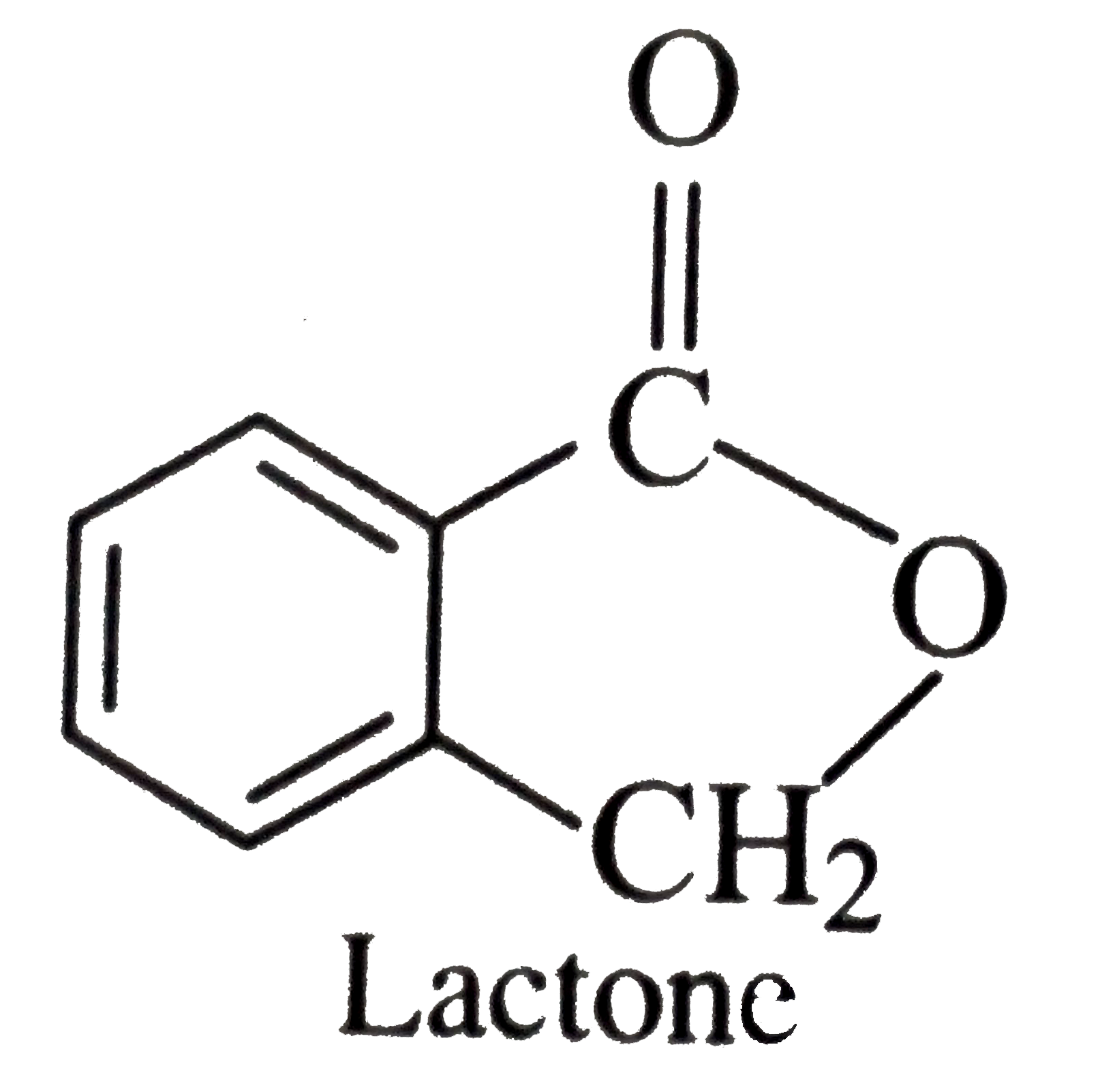 04:41View Solution
04:41View SolutionWhen benzene sulphonic acid and P-nitrophenol are treated with `NaHCO_3`, the gases released, respectively, are :
02:12View SolutionBenzamide on treatment with `POCl_3` gives :
01:11View SolutionAn enantiomerically pure acid is treated with racemic mixture of an alcohol having one chiral carbon. The ester formed will be :
01:42View SolutionEthylester `underset("excess")overset(CH_(3)CH_(2)MgBr)toP`. The product P will be
02:54View SolutionThe product of acidic hydrolysis of `P and Q` can be distinguished by
 05:52View Solution
05:52View SolutionBenzoyl chloride is prepared from benzoic acid by :
02:46View SolutionWhen propionic acid is treated with aqueous sodium bicarbonate, `CO_(2)` is liberated. The carbon of `CO_(2)` comes from
01:30View SolutionHydrogenation of benzoyl chloride in the presence of `Pd//BaSO_4` gives :
01:10View SolutionAcetamide is treated separately with the following reagents. Which one of these would give methyl amine ?
02:11View SolutionWhich of the following is basic ?
01:50View SolutionWith referenc eto the scheme given, which of the given statement (s) about T,U,V and W is/are correct?
 05:20View Solution
05:20View SolutionThe reation of `RCONH_(2)` with a mixture of `Br_(2)` and aqueous `KOH` gives `RNH_(2)` as the main product The intermediate (s) involved in this reation is (are) .
03:41View Solutionp-Hydroxybenzoic acid has a lower boiling point than o-hydroxybenzoic acid.
o-Hydorxybenzoic acid has intramolecular hydrogen bonding.01:51View SolutionAcetic acid does not undergo haloform reaction.
Acetic acid has no alpha-hydrogen.01:40View SolutionThe reaction of compounf P with `CH_(3)MgBr` (excess) in `(C_(2)H_(5))_(2)O` followed by addition of `H_(2)O` give Q the compound Q on treatment with `H_(2)SO_(4)`at `0^(@)` C gives R. the reaction of R with `CH_(3) COCl` in the presence of anhydrous `AlCl_(3)` in `CH_(2)Cl_(2)` followed by treatment with `H_(2)O` produces compound S. [Et in compound P is ethyl group] The product S is
 12:20View Solution
12:20View SolutionThe reaction of compounf P with `CH_(3)MgBr` (excess) in `(C_(2)H_(5)_(2)O` followed by addition of `H_(2)O` give Q the compound Q on treatment with `H_(2)SO_(4)`at `0^(@)` C gives R. the reaaction of R with `CH_(3) COCl` in the presence of anhydrous `AlCl_(3)"in" CH_(2)Cl_(2)` followed by treatment with `H_(2)O` produces compound S. [Et in compound P is ethyl group] The product S is The product S is
 12:20View Solution
12:20View SolutionP and Q are isomer of dicraboxylic acid `C_(4)H_(4)O_(4)` Both decolourixe `Br_(2)//H_(2)O`. On heating , P forms the cyclic anhydride. Upon treatment with duilute alkaline `KMnO_(4)`. P as well a Q could produce one or more than one from S,T and U.

Compounds formed P and Q are, respectively03:18View SolutionP and Q are isomer of dicraboxylic acid `C_(4)H_(4)O_(4)` Both decolourixe `Br_(2)//H_(2)O`. On heating , P forms the cyclic anhydride. Upon treatment with duilute alkaline `KMnO_(4)`. P as well a Q could produce one or more than one from S,T and U.
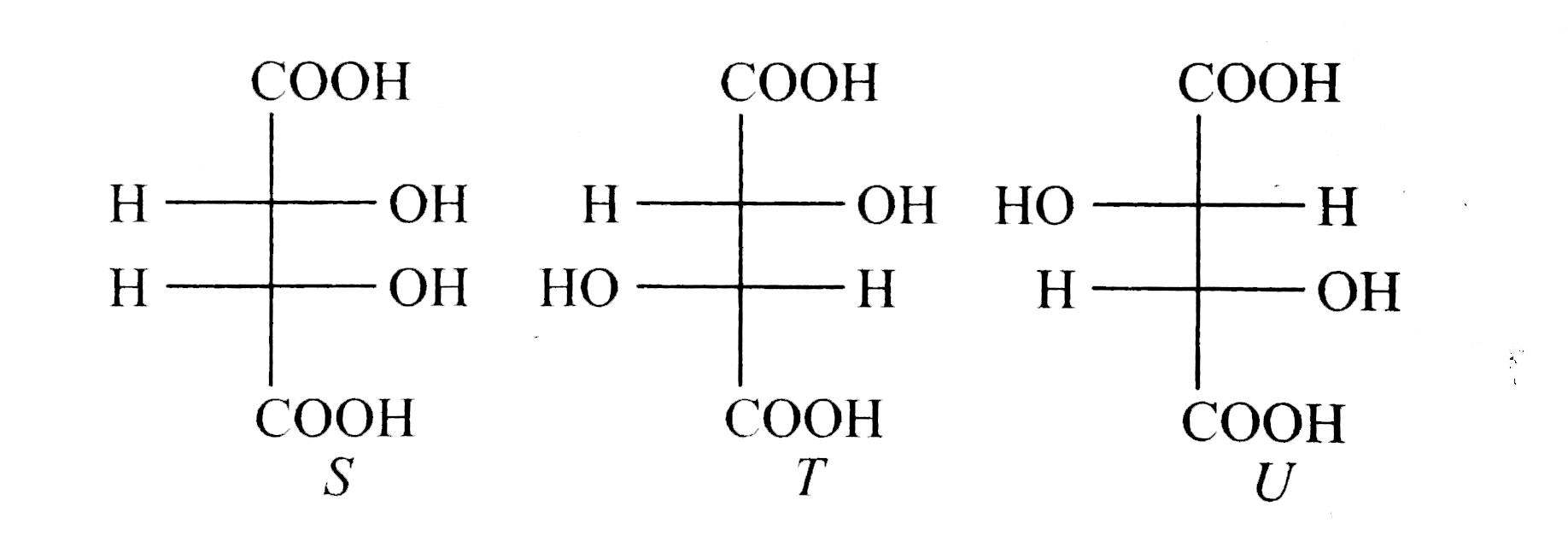
In the following reaction sequences V and W are respectively
`Qunderset(Delta)overset(H_(2)//Ni)rarrV`
 05:30View Solution
05:30View Solution`RCONH_2` is converted into `RNH_2` by means of Hofmann bromamide degradation.
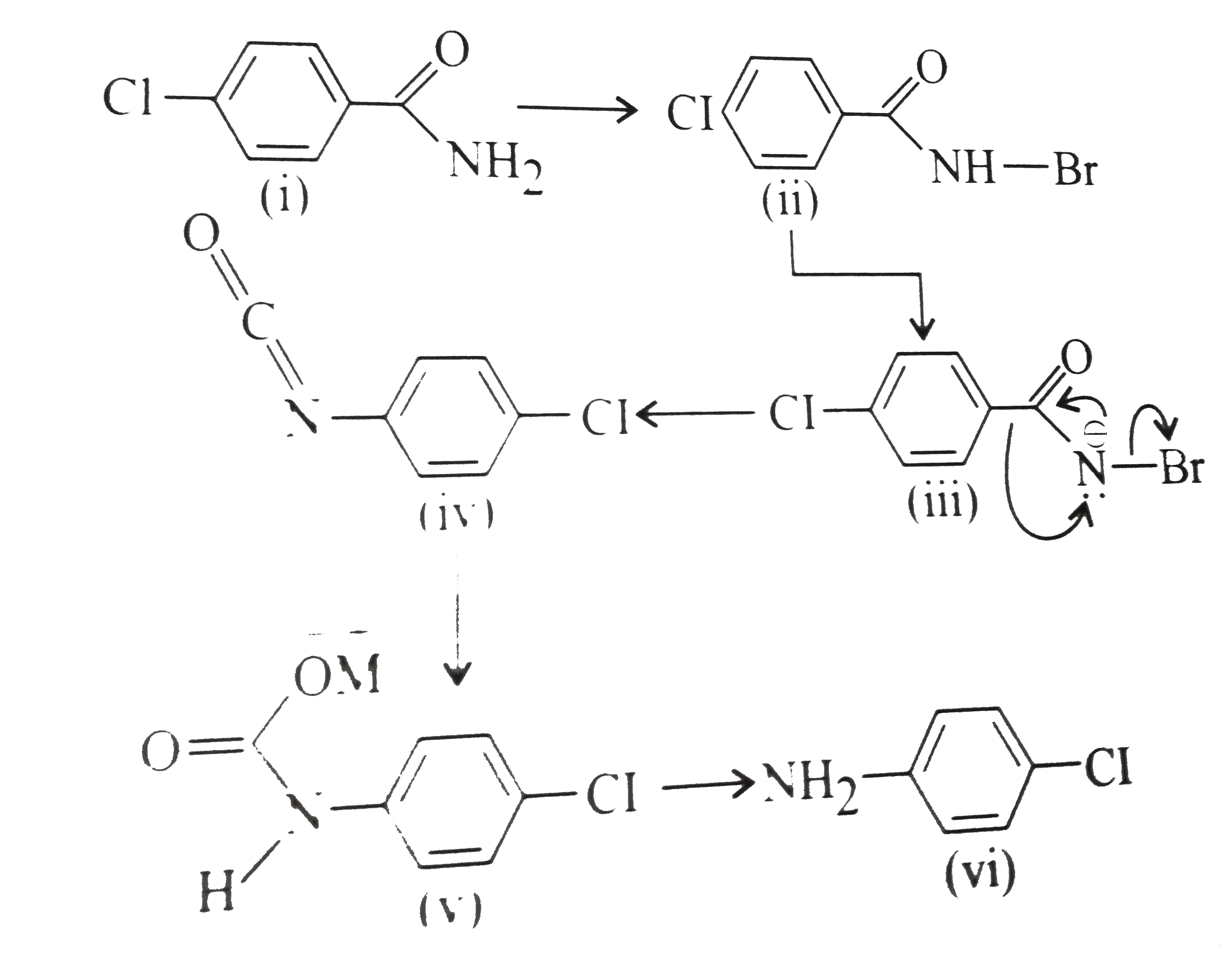
In this `RCONHBr` is formed form which this reaction has derived its name. Electron-donating group at phenyl activities the reaction. Hofmann degradation reaction is an intramolecular reaction.
Hoe can the conversation of `(i) to (ii)` be brought about ?05:29View Solution`RCONH_2` is converted into `RNH_2` by means of Hofmann bromamide degradation.
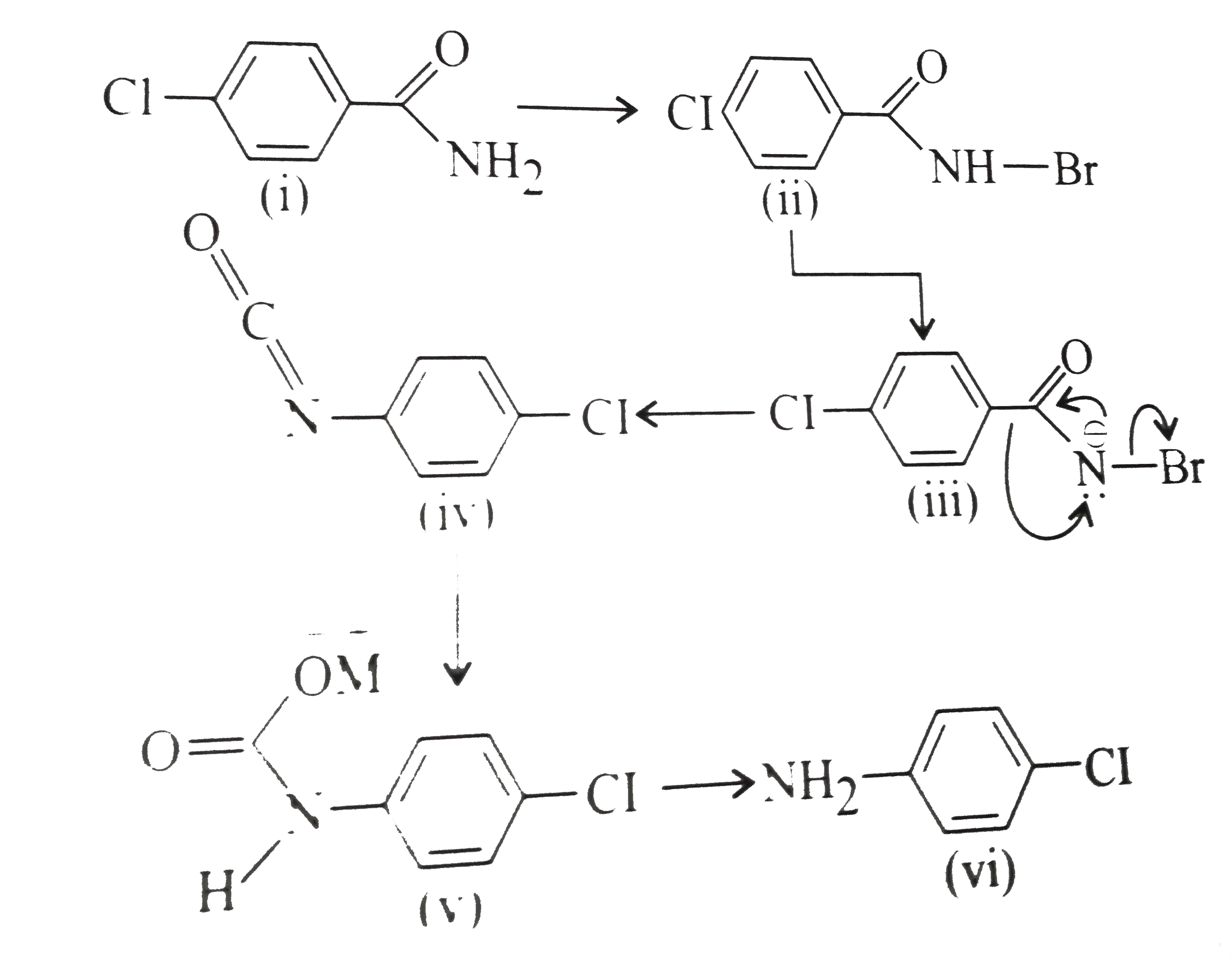
In this `RCONHBr` is formed form which this reaction has derived its name. Electron-donating group at phenyl activities the reaction. Hofmann degradation reaction is an intramolecular reaction.
Which is the rate-determining step in Hofmann bromamide degradation ?05:29View Solution`RCONH_2` is converted into `RNH_2` by means of Hofmann bromamide degradation.

In this `RCONHBr` is formed form which this reaction has derived its name. Electron-donating group at phenyl activities the reaction. Hofmann degradation reaction is an intramolecular reaction.
What are the constituent amines formed when the mixture of `(1)` and `(2)` undergoes Hofmann bromamide degradation ?
(1)
(2) .05:29View Solution
.05:29View SolutionFormic acid when heated with `conc . H_2 SO_4` produces …….. .
01:03View SolutionThe boiling point of propionic acid is more than that of n-butyl alcohol, an alcohol of comparable molecular weight.
01:17View SolutionHydrolysis of an ester in the presence of a dilute acid is known as
01:14View SolutionThe total number of carboxylic acid groups in te product P is:
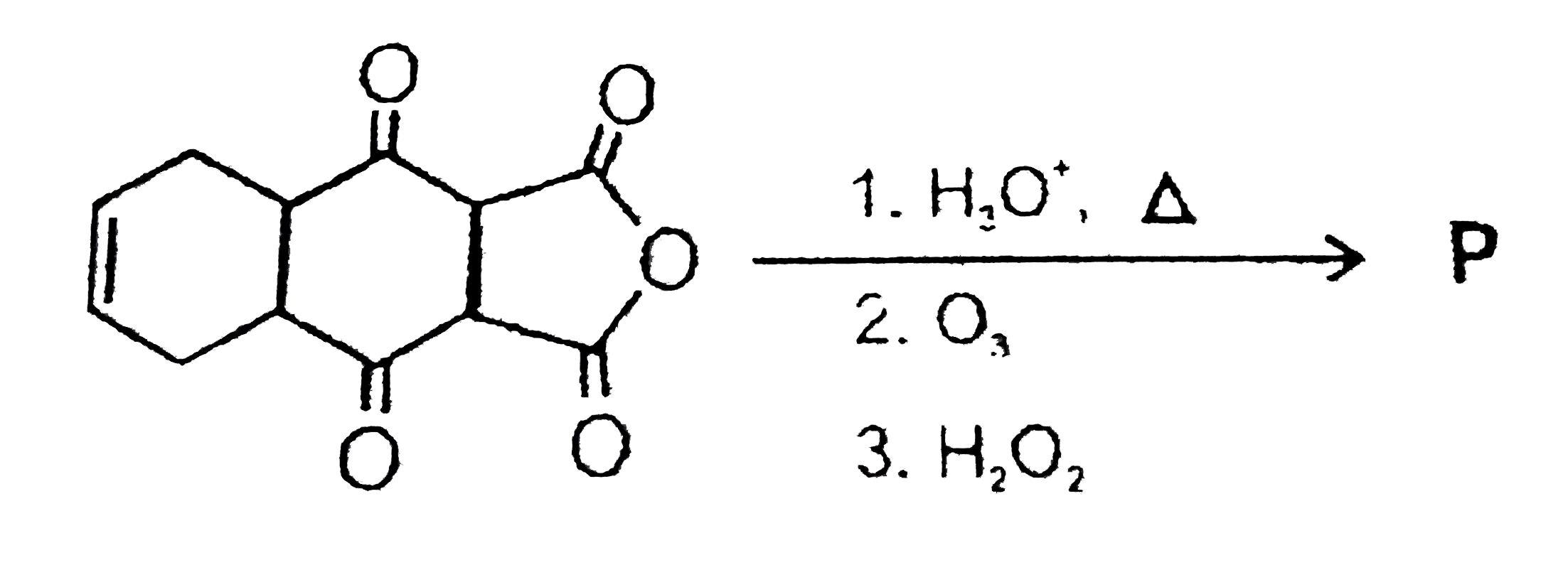 04:13View Solution
04:13View SolutionCompound A of molecular formula `C_(9)H_(7)O_(2)Cl` exists is keto form and predominantly in enolic form B. On oxidation with `KMnO_(4),` A give m-chlorobenzoic acid. Identify A and B
04:23View SolutionIdentify `Z + Y` in the following synthetic scheme and write their structures. Explain the formation of labelled formaldehyde `(H_2 C^(**) O)` as one of the products when compound `(Z)` is treated with `HBr` and subsequently ozonolysed. Take `C^(**)` as carbon in the entire scheme.
`BaC^(**) O_3 + H_2 SO_4 rarr X(C^(**) = C^(14))`
 .05:46View Solution
.05:46View SolutionWrite the structures of products `(A)` and `(B)`
`CH_(3) -overset (O) overset(||) C-overset(18) OC_2 H_5 overset(H_(3) O^(+))rarr (A) + (B)`.01:30View SolutionThe products `(A)` and `(B)` of the reaction
`CH_(3)CH_(2)NH_(2)underset(heat)overset((CH_(3)CO)_(2)O)rarr` .01:52View SolutionAn ester `A(C_4 H_8 O_2)`, on treatement with excess of methyl magnesium bormide followed by acidification, gives an alcohol `B` as the sole organic product. Alcohol `B` on oxidation with `NaOCl` followed by acidification gives acetice acid. Deduce the structures of `A` and `B`. Show the reactions involved.
05:39View SolutionA hydrocarbon `A` of the molecular formula `C_8 H_10`. On ozonolysis gives only the compound `B(C_4 H_6 O_2)`. The compound `B` can also be obtained from the alkyl bromide `C(C_3 H_5 Br)` upon treatment with `Mg` in dry ether followed by the addition of `CO_2` and acidification. Identify `A, B` and `C` and also give equations for the reactions.
07:09View SolutionComplete the following sequence of reactions with appropriate structures.
`CH_(3) -CH_(2) -COOH overset(P and ) underset("Bromide") rarr (A)`
`(A) overset((i) Alc. KOH (excess)) underset((ii) H^(oplus))rarr (B)`.01:36View SolutionWhich of the following carboxylic acids undergoes decarboxylation easily ? Explain briefly.
(i) `C_(6) H_(5) -CO-CH_(2)-COOH`
(ii) `C_(6) H_(5) -CO-COOH`
iii. `C_(6)H_(5)-underset(OH)underset(|)(CH)-COOH` (iv) `C_(6) H_(5) - underset(underset(NH_2) (|))(CH) -COOH`.03:20View SolutionPredict the major product in the following reaction :
`C_(6)H_(5) - CH_(2)COCH_(3)underset((ii)H^(+))overset((i)CH_(3)MgBr("excess"))rarr`02:21View SolutionIn the following reactions. Identify the compounds A, b, c and D
`PCI_(5)+SO_(2)toA+B`
`A+CH_(3)COOHtoC+SO_(2)+HCI`
`2C+(CH_(3))_(2)Cdrarr2D+CdCl_(2)`04:54View SolutionComplete the following sequence of the reactions with approprite structures.
(i) 02:33View Solution
02:33View SolutionIn the following identify the compounds/reaction conditions represented by the alphabets `(A), (B)`, and `( C)` :
`C_(6) H_(5) COOH overset(PCl_5)rarr (A)overset(NH_(3)) rarr (B) overset(P_2 O_5)rarr C_(6) H_(5) CN overset(H_2 //Ni)rarr (C)`.01:33View SolutionArrange the following as stated :
'Increasing order of acidic strength'.
`ClCH_(2) COOH, CH_(3) CH_(2) COOH, ClCH_(2) CH_(2) COOH, (CH_(3))_(2) CHCOOH, CH_(3) COOH`.03:25View SolutionHow will you bring about the following conversion ?
'Ethanoic acid to a mixture of methanoic acid and diphenyl ketone'.03:09View SolutionGive reasons for the following :
'Carbon-oxygen bond lengths in formic acid aer `1.23 Å` and `1.36 Å` and both carbon-oxygen bonds in sodium formate have the same value, i.e., `1.27 Å`.01:37View SolutionWrite the balanced equations for the following reaction :
'Acetamide is reacted with bromine in the presence of potassium hydroxide'.01:30View SolutionA liquid `(X)` having a molecular formula `C_(6) H_(12) O_(2)` is hydrolysed with water in the presence of an acid to give a carboxylic acid `(Y)` and an alcohol `(Z)`. Oxidation of `(Z)` with chrome acid gives `(Y)` . What are the structures of `(X), (Y)`, and `(Z)` ?
03:08View SolutionComplete the following with appropriate structures :
`(CH_(3) CO)_(2) O overset(C_(2)H_(4) OH)rarr CH_(3) COOH + ?`.01:09View SolutionArrange the following in order of their increasing ease of hydrolysis :
`CH_(3) COOC_(2) H_(5), CH_(3) COCl, (CH_(3) CO)_(2) O, CH_(3) CONH_(2)`.01:19View SolutionGive reason in one or two sentences for the following : 'Formic acid is a stronger acid than acetic acid'.
01:48View SolutionWrite down the reactions involved in the preparation of the following using the reagents indicated against in parenthesis.
'Propionic anhydride from propionaldehyde'.
`[AgNO_3, NH_4 OH, P_2 O_5]`.01:53View SolutionGive reasons for the following in one or two sentences.
'Acetic acid can be halogenated in the presence of `P` and `Cl_2`, but formic acid cannot be halogenated in the same way'.01:20View SolutionState with balanced equation what happens when 'Acetic anhydride reacts with phenol in the presence of a base'.
01:10View SolutionWrite the structural formula of the main organic product formed when ethyl acetate is treated with double the molar quantity of `MeMgBr` and the reaction mixture is poured into `H_2 O`.
02:38View SolutionWrite the chemical eqution to show what happens when 'Ethyl acetate is treated with sodium ethoxide in ethanol and the reaction mixture is acidified'.
02:07View SolutionFischer esterification of phenylacetic acid with 1- propanol gave a mixture of `93%` of the ester, propyl phenylacetate, contaminated with `7%` unreacted acid. Which of the following treatments would be best used to purify the ester?
02:51View SolutionThe `C-NH_(2)` bond in acetamide is 0.1 A shorter than the `C-NH_(2)` bond in ethylamine. Way?
02:11View SolutionWhich of the following reaction will produce isopropyl acetate in the best tield?
04:06View SolutionAn organic acid (X) has molecular formula `C_(8)H_(16)O_(2^.)` X on heating with `NH_(3)` forms Y which on treatrmentr with alkaline `Br_(2)` from Z.Z on treatament with `HNO_(2)` followed by with `H_(2)SO_(4)` gives 2,4- dimethyl l-2 pentene. How many different acids (X) can give the indicated final product?
06:42View SolutionIn the following Cross-Clasisen condensation reaction, how many different `beta-keto` esters would be formed?
`CH_(3)CH_(2)COOC_(2)H_(5)+CH_(3)COOC_(2)H_(5)underset("heat")overset(C_(2)H_(5)ONa)rarr`05:28View Solution
JEE Main And Advanced questions and complete solutions for chapter CARBOXYLIC ACID AND THEIR DERIVATIVES of IIT-JEE PREVIOUS YEAR (CHEMISTRY) of Class 12
